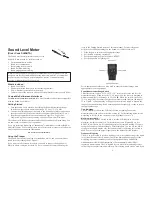
use the Sound Level Meter to get the total unweighted sound level of the noise
source. For more details about A
vs.
C weighting scales, see
www.vernier.com/til/3500
The sensor comes with a foam windscreen. The windscreen helps reduce the
detection of false high signals caused by wind blowing across the microphone. It
also protects the microphone from dust and debris.
Calibration
You should not need to calibrate the Sound Level Meter for classroom use.
Calibration is possible, but it will require access to a special calibrator, capable of
producing sound at a particular frequency at a pre-determined sound level, not
commonly available in the classroom.
Specifications
Sensor
1/2" electret (prepolarized) condenser microphone
Power
Four AAA batteries
Battery life
50 hours typical
Display
3 1/2" LCD
Measurement
range
Low: 35 to 90 dB
High: 75 to 130 dB
Frequency range
31.5 to 8000 Hz
Resolution
0.1 dB
Accuracy
1.5 dB (ref 94 dB @ 1 kHz)
Output
DC: 10 mV/dB
AC: 1.0 Vrms corresponding to the top of the selected range
Stored calibration
Slope: 100 dB/V
Intercept: 0 dB/V
How the Sensor Works
The Sound Level Meter uses an electret condenser microphone mounted on the
end of a shaft. The output of this microphone is fed into a series of filters,
amplifiers, integrators, and adder circuits to produce a single sound pressure level
measurement. The Sound Level Meter uses a directional microphone, which
requires the instrument to be pointed in the direction of the noise source unless
ambient noise levels are being monitored.
Suggested Sound Level Studies
You can collect sound level data in many real-world situations; for example, you
can
Collect sound levels before, during and after a concert or dance.
Collect sound levels throughout the day in a school hallway or shopping mall.
3
Use the Sound Level Meter to judge cheering contests at pep rallies.
Collect data outside and inside a car equipped with a stereo system.
Make a model of an ear and ear canal. Measure sound levels at the “ear drum”
when a headset is placed over the ear. Repeat the experiment but place an
earplug between the headset and the meter.
Set up the Sound Level Meter to collect readings in a variety of situations. Use
the following chart to determine the acceptable duration for exposure to the
sound level you measure.
The following chart shows the sound level exposure rates set by the OSHA
Occupational Noise Exposure Standard. In a work environment, for example, it is
acceptable to be exposed to 90 dB for eight hours as measured on the A-weighted
scale. If the sound level is 100 dB, the acceptable duration is two hours.
Duration per day (hrs)
Sound level, slow-response (dBA)
8.0
90
6.0
92
4.0
95
2.0
100
1.0
105
0.5
110
0.25
115
4






















